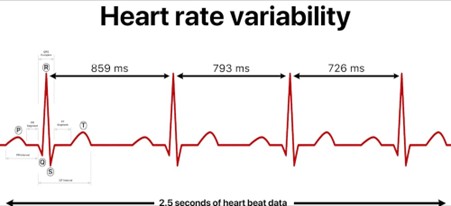Decoding Your Heart's Rhythm: What Heart Rate Variability Tells You
We all know about the importance of a healthy heart rate, but the fairly recent emergence of interest in Heart Rate Variability (HRV), intrigues me.
If you are unaware of this, let me give a quick summary:
HRV is the slight variations in timing between heartbeats and can offer valuable insights into your overall health and well-being. Think of it this way: a truly healthy heart isn’t a rigid metronome, but rather a responsive instrument that subtly adjusts its tempo.

YitzhakNat via Wikimedia Commons, CC BY-SA
The Symphony of Your Autonomic Nervous System
These tiny fluctuations in your heartbeat are orchestrated by your autonomic nervous system (ANS), which manages many of your body’s automatic functions. The ANS has two main branches:
- The Sympathetic Nervous System: This is your body’s “gas pedal,” responsible for the fight-or-flight response. When you’re under stress, excited, or exercising, this system kicks in, generally making your heart beat faster and more regularly, which leads to lower variability.
- The Parasympathetic Nervous System: This is your body’s “brake,” often called the “rest-and-digest” system. It’s more active when you’re relaxed and recovering, allowing your heart rate to be more flexible and resulting in higher variability.
Why HRV Matters: A Sign of Adaptability
A higher HRV generally indicates that your heart and nervous system are adaptable and resilient. It suggests a good balance between your body’s stress response and relaxation capabilities. Your heart is like a well-tuned engine that can smoothly adjust to different demands.
Conversely, lower HRV can be a sign that your body is under stress, whether from physical exertion, emotional strain, or underlying health issues. It might mean your “gas pedal” (sympathetic system) is more dominant, and your heart isn’t as flexible in responding to different situations. Low HRV can indicate that your regulatory systems are less able to adapt to changes.3 Deterioration in HRV is considered a sign of disease and may indicate an increased risk of mortality.3
Measuring the Heart’s Rhythms
Researchers and health professionals use various methods to measure HRV by analysing the time intervals between heartbeats. These measurements are often looked at in two main ways:
- Time Domain: This looks at the duration of the intervals between heartbeats. Measures like SD (Standard Deviation) and Variance reflect the overall variability.2
RMSSD (Root Mean Square of Successive Differences) is particularly sensitive to short-term changes and is often linked to the “rest-and-digest” system.3 - Frequency Domain: This examines the patterns of these variations, breaking them down into different frequency bands. HF (High Frequency) is often associated with parasympathetic activity, while LF (Low Frequency) can be influenced by both branches of the ANS. The LF/HF Ratio is sometimes used to assess the balance between sympathetic and parasympathetic activity.2
These measures help provide a picture of how well your autonomic nervous system is managing your heart’s rhythm.
Pilates and Breathing: Tools for a Harmonious Heart
Exercise, including Pilates, and breathing exercises have been shown to influence HRV.3
- A Pilates session can temporarily decrease HRV2 as more demands are placed on the heart. It is like driving your car up a hill and having to push the accelerator hard to make it. This would be anticipated with any exercise.
- However, regular Pilates training over weeks can lead to positive adaptations in HRV, indicating improved autonomic balance. After two weeks of training, Pilates induced an increase in RMSSD and the LF/HF ratio. Studies have shown that Pilates can increase RMSSD and improve the LF/HF ratio.2 Improvements in SDNN and LF parameters have also been demonstrated after a 12-week Pilates exercise program.3
- Interestingly, the benefits of Pilates on HRV may be enhanced when combined with slow, controlled breathing exercises. A study comparing a Pilates group, a breathing exercise group, and a combined Pilates and breathing exercise group found that the most significant improvements, an increase in RMSSD, was observed in the combined group. in addition, increases in SDSD, SDNN, TP, HF, and LF were observed in both the breathing group and the combined group.1
- Research also indicates that Pilates can positively affect HRV in specific populations, such as women and individuals with type 2 diabetes.2
- One study suggests that a higher frequency of Pilates training (three times a week) with progressively increased intensity might be more effective in improving HRV in both time and frequency domains.3 This study used shorter periods between exercises over time. The authors queried whether other ways of increasing intensity, like increasing springs or exercise difficulty might have resulted in better outcomes.
In Conclusion: Nurturing Your Heart’s Rhythm
While a single Pilates session might temporarily alter heart rate variability, consistent practice, especially when combined with mindful breathing, appears to have a positive influence on HRV over time. This suggests that engaging in activities like Pilates, which often integrates controlled breathing, can contribute to a healthier and more adaptable cardiovascular system.1,4 By understanding and potentially improving HRV through exercise and breathing practices, individuals can take proactive steps towards better overall health and well-being.
By Robyn Rix, PAA President
References
- Adıgüzel, S., Aras, D., Gülü, M., Aldhahi, M. I., Alqahtani, A. S., & AL-Mhanna, S. B. (2023). Comparative effectiveness of 10-week equipment-based pilates and diaphragmatic breathing exercise on heart rate variability and pulmonary function in young adult healthy women with normal BMI – a quasi-experimental study. BMC Sports Science, Medicine and Rehabilitation, 15(1), 82.
- Gouveia, S. S. V., Gouveia, G. P. de M., Souza, L. M., da Costa, B. C., Sousa, G. H. M., Pinho, V. A., Vasconcelos, S. S., Souza, A. T. D. S., Lopes, T. da S., & Pinheiro, L. G. P. (2022). Heart Rate Variability and Respiratory Muscle Strength in Patients With Type II Diabetes Practicing Pilates: A Randomized Clinical Trial. Current Diabetes Reviews, 18(6), e280921196866.
- Ribeiro Almeida, Naiara; Pires, Washington; Aedo Muñoz, Esteban; Carrenho Queiroz, Andréia Cristiane; Valenzuela Pérez, Diego Ignácio; De Toledo Nóbrega, Otávio; Miarka, Bianca; José Brito, Ciro. Acute and chronic effects of Pilates on the cardiovascular autonomic system. Journal of Physical Education & Sport, 2025, Vol 25, Issue 2, p413.
- Rocha, Jeferson; Cunha, Felipe A.; Cordeiro, Ricardo; Monteiro, Walace; Pescatello, Linda S.; Farinatti, Paulo. Acute Effect of a Single Session of Pilates on Blood Pressure and Cardiac Autonomic Control in Middle-Aged Adults With Hypertension. Journal of Strength and Conditioning Research 34(1): 114-123, January 2020.

Comments are closed.